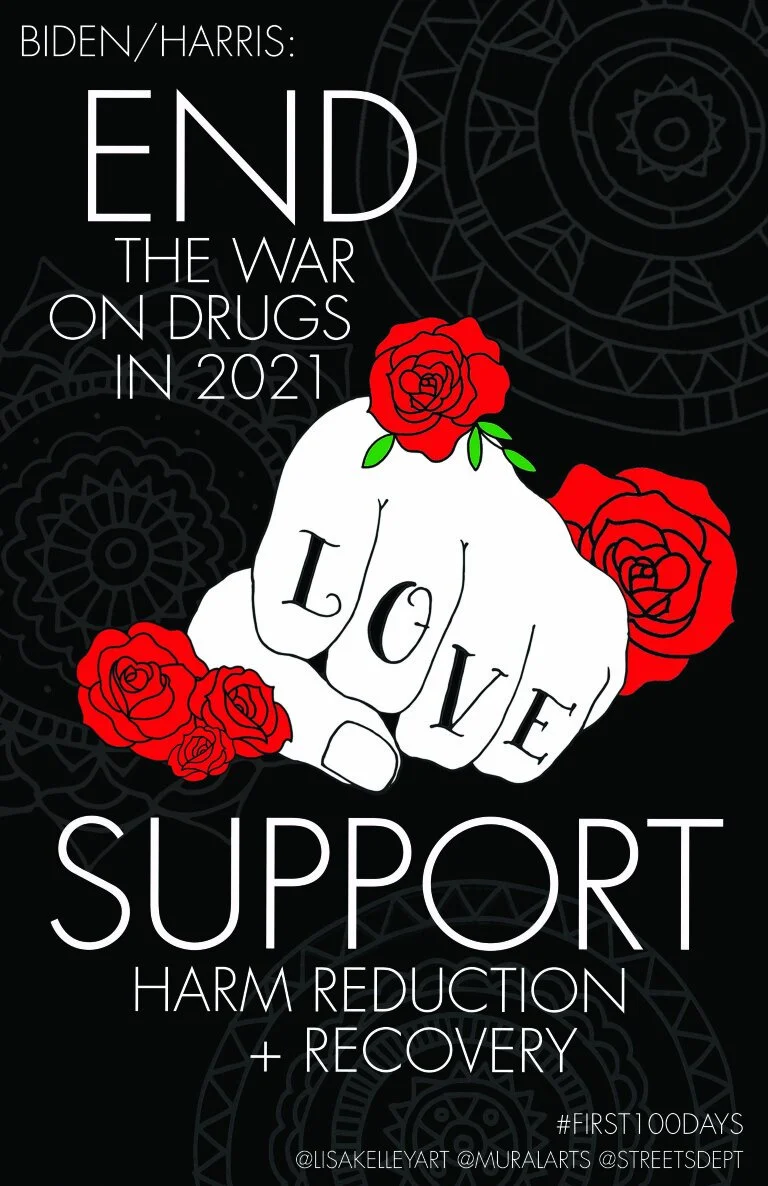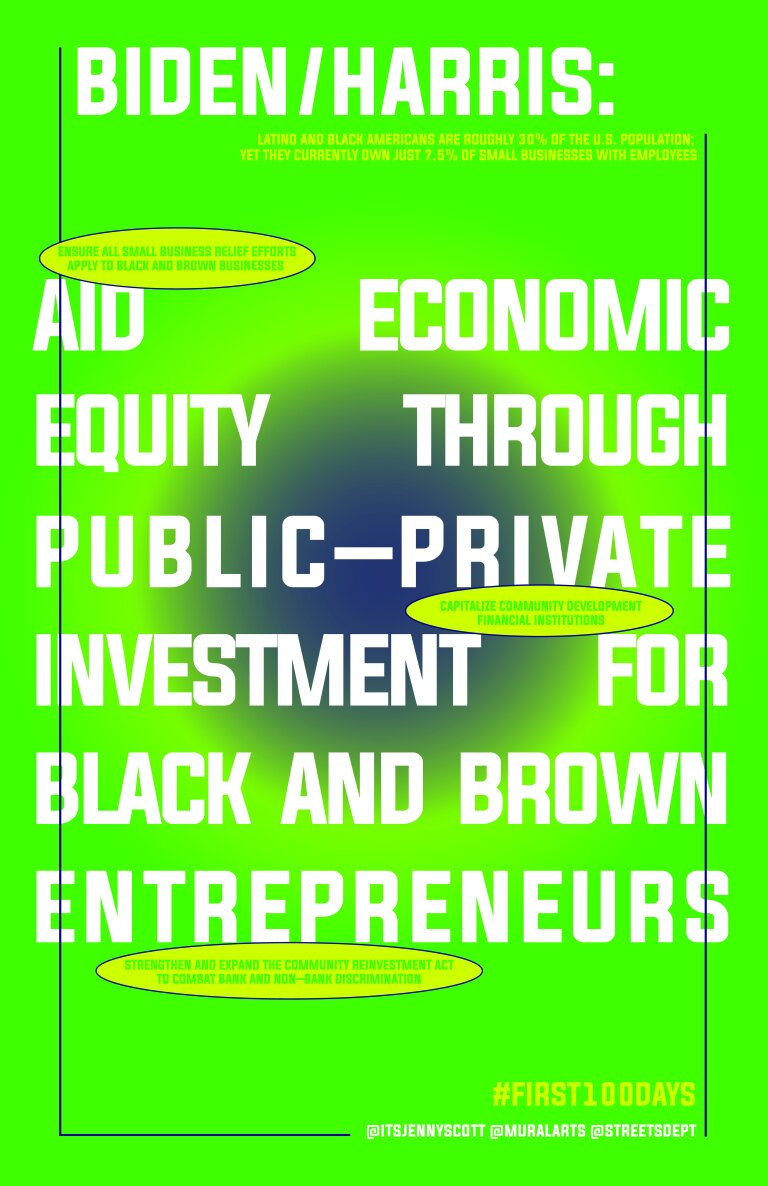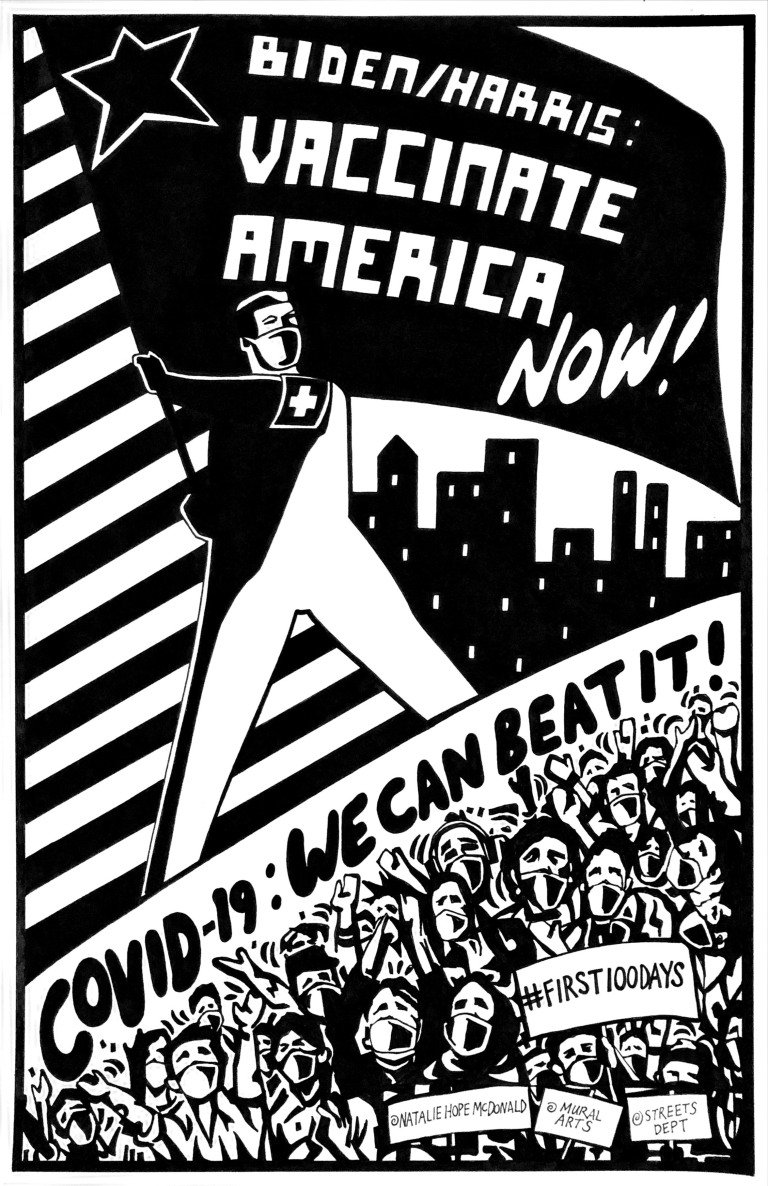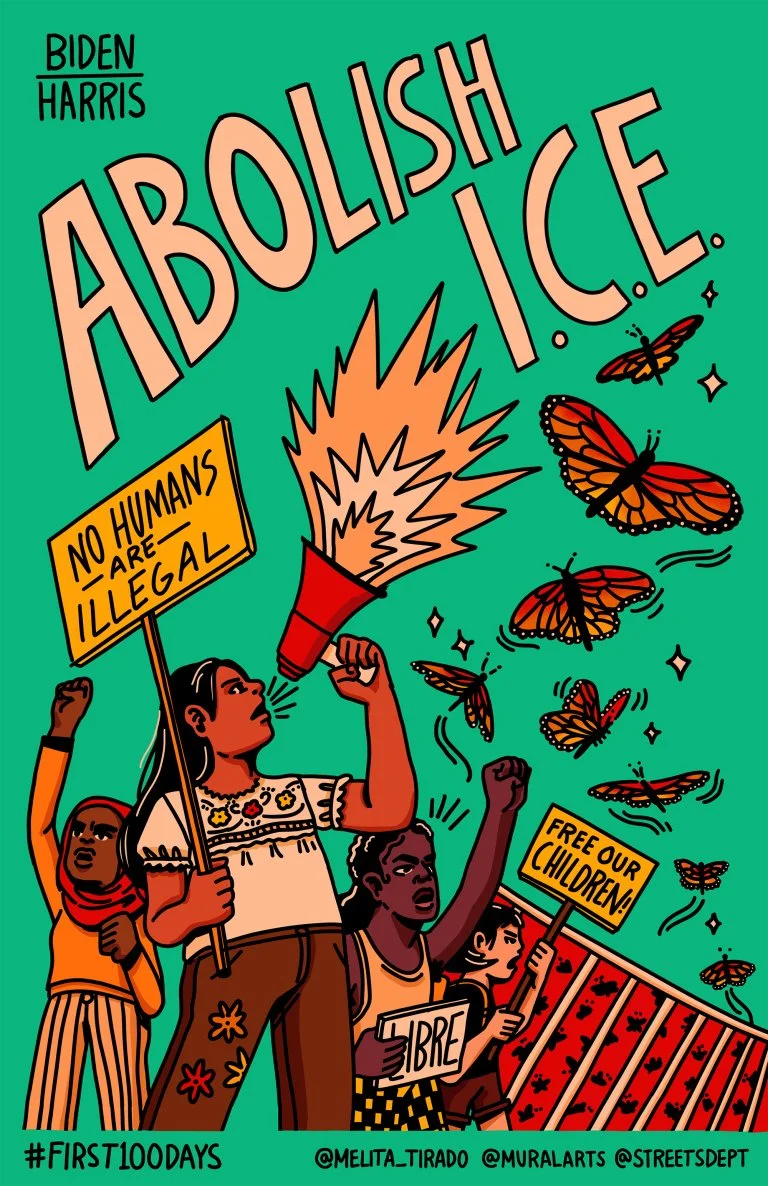Q & A
Art for the People: A Conversation with Conrad Benner
Earlier this year, at the behest of Collab, the Philadelphia Museum of Art invited curator, artist and blogger Conrad Benner to contribute to the Museum copies of the First 100 Days political posters that he curated with Mural Arts.
Article reposted with permission from the Philadelphia Museum of Art.
Curator Kathryn Hiesinger speaks with the StreetsDept.com founder on the power and necessity of public art.
Conrad Benner, founder of the Philly blog Streets Dept, and Mural Arts Philadelphia recently gave the museum a collection of posters from the First 100 Days art project, which Benner created and curated. The project was designed to engage the public around policy issues that could be addressed by President Joe Biden and Vice President Kamala Harris during their first 100 days in office. The gift came to the museum through Collab, a group that supports modern and contemporary design at the museum.
KH: On your blog you write, “Why posters? It’s simple: messages in the public space can work to influence the discussion.” Tell us about the project and its impact so far.
CB: The response has been incredible. One example of that excitement is that in addition to offering these poster files for free to download and print online, we also organized several free handouts of the posters and each saw lines of people! I even started seeing our posters in windows around my South Philly neighborhood almost immediately. People see the value in window posters like this. From the protest signs folks have been keeping in their windows since the Black Lives Matter movement protests of 2020 to political campaign signs, I think people understand the power of the quasi-public space that they curate: their home windows. And messages in the public space do have an effect, otherwise we wouldn’t have advertisers spending millions of dollars each year on outdoor ads. Our “ads” just speak to some of the more immediate hopes and concerns of this new Biden and Harris administration through the lens of art.
KH: What do you think is the role of public art in community building, and in the life of a city more generally?
CB: A city is its public space. Our public space offers us community and opportunity. It can bring people together or allow for time alone. Our public space invites inspiration, conversation, and connection to people, nature, and ourselves. And unlike so much of the rest of digital and physical spaces that currently make up the world around us, our public space isn’t driven by profit, it exists for people first. For that reason the art in our public space can work to employ artists and engage communities to create public art that reflects them, their values, and their hopes. And access to that artwork is unrestricted. Art and public space are invaluable to a city, and access to both can make people and cities flourish.
KH: What makes Philly such a great city for people who love art, particularly public art?
CB: Well we’re the public art capital of the US, of course! And unlike some other cities in this country that have created mural districts to attract visitors, Philly’s public art is spread through the entire city. Art is for everyone, and I think in Philly we really strive to make that a reality.
KH: You have been photographing and documenting art on the streets of Philadelphia for years, even before you founded your wildly popular photo-blog StreetsDept in 2011. In your self-described role as curator of that blog, and as one curator to another, how have you seen the styles and subjects of street art in Philadelphia change or evolve over time?
CB: In the last decade I’ve noticed two big shifts. First, when Instagram came out it offered visual artists a tool to not only create work but also work as their own promoter. This allowed many artists to excel outside of the traditional curatorial/gallery world. It also opened the door to many street artists to start making art that could have especially ephemeral lifetimes in the physical public space (sometimes existing for mere minutes), but still enter the public consciousness, not years later in some photographer’s book, but immediately, through a viral social-media photo. This meant artists could play more and take greater risks. The second shift was after the election of Trump. Art has always reflected our time, and street art has always been political by its nature of not seeking permission, but after 2016 I started to see more and more artists using their talents and abilities to push back with their art to demand visibility, equity, and justice directly.
KH: Political posters have a long and distinguished history, one that influences many of the aesthetic choices designers make today. Who are the graphic designers and artists—past and present—that inspire you the most?
CB: This is an interesting question because the focus of my career has been on street art and murals, not posters. In fact, First 100 Days was only the second poster project I ever created/curated. But when reading this question my mind immediately went to Keith Haring. Not only do I admire Keith’s street art/graffiti work, but I love how he then used his iconic imagery to draw folks attention to important issues, including HIV/AIDS. Art can make people feel things, art can tap into those unconscious parts of our being, and I think our power often comes from igniting that.
Brunofsky: Cancelling Student Debt: “I have watched many loved ones carry this weight with them for far too long. Add in a pandemic that has caused alarmingly high unemployment rates and the incompetence of the 45th president, now is the time to cancel student debt.” | @brunofsky
Krista Dedrick-Lai – Closing immigrant camps: “As a mother, I cannot find words for the horror I feel about what has been done to imprisoned immigrant children and families. I have no words for the rage I feel at how little has been done by our government to right its wrongs, or even to stop them. Families belong together.” | @krista_dedrick_lai
Marisa Velázquez-Rivas – Environmental justice: “Climate change is a racial justice problem—if you’re a person of color you’re more likely to live in locations terrorized by toxic facilities, flooding, climate-related disease, and other issues…It’s so important to expand the conversation around climate justice — ensuring that all people, regardless of race and ethnicity, get equal protection from the worst effects of climate change.” | @marisa.vr
Lisa Kelley – Harm reduction: “Harm reduction is the practices, policies and programs aimed at reducing harm associated with drug use… People who use drugs deserve services and resources that meet them “where they’re at,” whether that is actively using drugs or attaining abstinence.” | @lisakelleyart
Candy Alexandra González – Housing for All: “Everyone is deserving of safe, accessible, and affordable housing. In the devastation caused by COVID-19, it has been our most vulnerable citizens who have been hardest hit.” | @candy_alexandra1
Jenny Scott – Racial economic equity: “We live in an economy based on private owners monetizing goods for financial stability. Given that bureaucratic structures have been historically riddled with racist intentions, Black and brown businesses are statistically afforded less financial resources…” | @itsjennyscott
Jonai Gibson-Selix – Reallocating Police Budgets: ”… there is no amount of money that can be invested in police reform that will fix this broken system. Fund public services, divest from police.” | @byjonai
Marian Bailey – Reopening schools safely: “Over the last year, I’ve seen countless posts about teachers that have contracted Covid-19 and lost their lives. We live in a space that treats teachers like glorified babysitters and it is horrifying. Teachers deserve more money, more support, and should be kept in mind when folks are discussing the full reopening of schools.” | @_mcbailey
Derick Jones – Universal Healthcare: “The government and the people in charge mess with our lives on a daily basis, the least they could do is make sure we’re healthy enough to keep taking a beating.” | @skudsink
Natalie Hope McDonald – Vaccinating the country: “I can’t think of anything more urgent right now than getting COVID-19 vaccines to more people. If we can inoculate as many Americans as possible within the first part of this new year, we can and will save lives.” | @nataliehopemcdonald
Melita Tirado – Abolishing I.C.E.: “Being a first-generation Peruvian-American from two immigrant parents, I resonate with the agony they (ICE) have caused the Latinx/e community in it’s immoral separation and deportation of our people… The new administration needs to abolish ICE urgently because it never should have existed in the first place.” | @melita_tirado
Donte Neal – $15 Minimum Wage: “I chose to focus on this topic in light of the many people in my family and friend groups that have currently fallen on hard times. Hardworking folks across the country have found themselves unable to support themselves and/or their families on the current minimum wage of $7.25…” | @donteneal_
Kah Yangni – $2,000 stimulus checks: “We live in one of the wealthiest countries on the planet. There is no reason for people here to be suffering in the middle of this crisis. We need Biden and Harris to step in and give us the resources we need to survive.” | @kahyangni
A photo-blogger, curator, and podcaster, Conrad Benner was named one of the most influential people in Philly by Philadelphia Magazine in 2020. His work has explored art, our public space, and the creative minds shaping the world around us. He was born and raised in Fishtown, Philadelphia.
Kathryn B. Hiesinger, PhD, is the museum’s J. Mahlon Buck, Jr. Family Senior Curator of European Decorative Arts after 1700.
All posters on this page are from the “First 100 Days” Project (Gift of Conrad Benner and Mural Arts Philadelphia through Collab: The Group for Modern and Contemporary Design, 2021). Published 2021.













